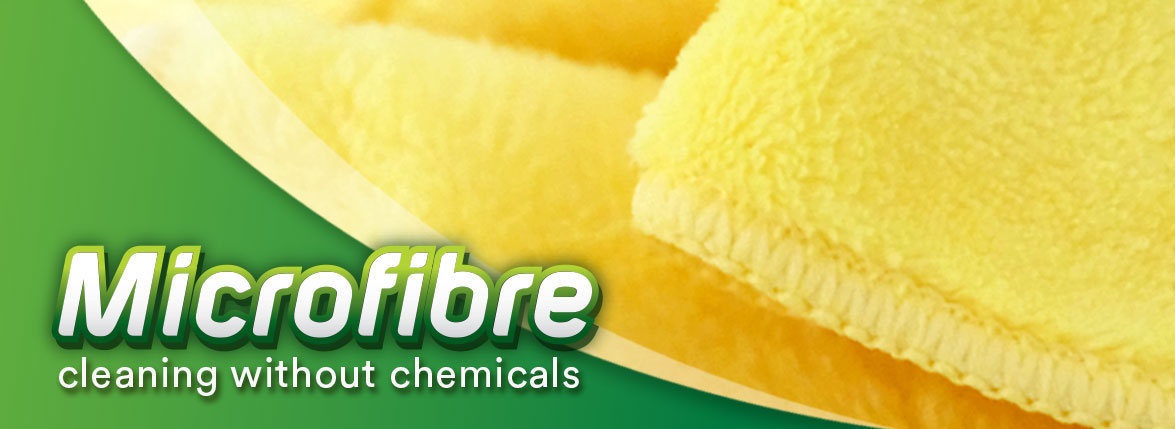
Microfibre will make cleaning easy, efficient, and effective. The best part is you don’t need chemical cleaners, as microfibres trap dirt, and remove 99.9% bacteria with water alone.
Here are all the tips and tricks you need to know when it comes to cleaning with microfibre and caring for your microfibre. Just grab a cuppa and start reading.

How to care for your microfibre.
The first thing to know about microfibre, is how to take good care of it! For ultimate care, Microfibre should be washed in cool to warm water (below 40 degrees) to best preserve the quality. It’s also important to use a mild water based detergent when washing – oily soap is a no-go! Remember to Avoid fabric softeners as they coat the fibres, preventing them from trapping dirt & dust and making the fabric unusable.
Tip: Be careful what you wash your microfibre with. Avoid anything made with cotton, as the microfibre will grab on to the lint, damaging the fabric. To avoid this, washing in a delicates bag would keep your cloths tip-top condition.
Suggested products: Sabco All-Purpose Microfibre Cloths, Sabco SuperSwish Spray Mop

The superpower of microfibre.
Why use single use, disposable paper towels to wipe away any countertop messes?! Paper towel will just move dirt & dust across surfaces. Microfibre cloths trap the grime and lift it away, and since they’re reusable, you’ll be doing the planet a favor!
Instead of using a chemicals, the cloths unique fibre structure picks up 99.9% of bacteria with just water.
Say goodbye to counter spray unnecessary chemicals in your home!
Suggested products: Sabco All Surface Microfibre Cloths, Sabco Extendable Feathered Microfibre Duster with Flexible Head

500 times! Long-lasting!
Microfibre cloths can last a long time, as they can be washed and re-used up to 500 times. This makes microfibre one of the most economical cleaning materials currently existing in the market!
Suggested products: Sabco Dusting Microfibre Cloths

Microfibre cloths & their multi-purpose function.
A multi-purpose tool to help us cleaning our spaces. Microfibre can be utilised for:
- Reflective surfaces like windows and stainless steel. Microfibre cloths are great to use on reflective surfaces as they leave a streak-free finish.
- Bench tops, microfibre cloths are ideal to remove grime, food residues, liquids, and all types of mess you make while cooking. The microfibre cloths trap the grime and lift it away using just water!
- Skirting boards, the microscopic split fibres will grab dust and dirt with one wipe.
- Bathroom surfaces. Keep a separate set of microfibre cloths for bathroom cleaning and replace more often. As you only need water to clean, you can even keep one in the shower and give it a once-over while you are in there. Be sure to wring out the cloth, as it can hold up to eight times its weight in water and will get mouldy if left completely soaked.
- Use DRY on Electronics like laptops, mobiles, and tablets can get grimy with constant use. Microfiber cloths are gentle enough for the fragile screens, so you can give them a good wipe-down without worrying about damage (as before use the lint-free microfibres for delicate surfaces).
- Suggested products: Sabco Superswish Xtra Mop, Sabco Microfingers Duster, Sabco SuperSwish Duo

Smart way to use your microfibre cloths: Colour Coding!
Using one cloth for all spaces can transfer germs and bacteria around the home. The cleaning industry professionals came up with a smart way to tackle this problem. By using different coloured microfibre cloths, you will avoid transferring any germs or bacteria around the home. For example:
- Green cloths – Kitchen Benches
- Yellow cloths – Kitchen Stovetop
- Blue cloths – General Cleaning and Dusting
- Red cloths – Bathroom
- Orange cloths – Toilet
Suggested products: Sabco All Surface Microfibre Cloths

How to Tell Your Microfiber is Worn Out?
Signs your microfibre cloth is becoming worn out can include a rough feel to the cloth itself. While this doesn’t mean that the cloth is useless, you should still consider replacing it soon.
Typically, the first signs of wear on your microfibre cloths will be visual. If you notice frayed material or streaks while cleaning, your cloths might be close to needing replacement.

Storage your microfibre cloths.
Very important is once you have washed, dried and folded your microfibre cloths, store them in a container or drawer to protect them from the environment. Microfibre is so great at picking up dust and dirt, leaving them out in the open can cause them to get dirty before you even use them again!
Make sure to take good care of your microfibre products and it will ensure a long-lasting usage.
Sabco isn’t just a company, but part of the Australian way of life. We’re proud to have been in the cleaning business since 1892, and stand behind all our products. That is why we have been the cleaning experts for over 100 years.
